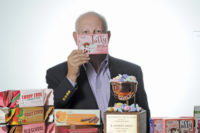R. Anthony, aka “Tony” Sweet never dreamed of being a Kettle Award recipient. In fact, he steadfastly refused to be nominated, believing any accomplishments he had achieved were part of a team effort rather than an individual accolade. Fortunately, this year, his daughter, Rachel Sweet, and nephew, Rick Kay, convinced him to change his mind, successfully arguing that it was time for the self-described “shy guy” to accept the honor of becoming a nominee.
Even upon hearing his name called out as a nominee that May night in Chicago’s Union League Club, Tony remained his humble self; he felt honored just to be in the company of the other three nominees: James Buffardi, cfo for Ferrara Pan Candy Co.; Mitchell Goetze, president and ceo of Goetze’s Candy Co.; and Charles Flavelle, chairman of Purdy’s Chocolates.
It was then that Katherine Clark, chairperson of Candy Industry’s Kettle Committee received the envelope containing the name of the 67th Kettle Award recipient.
“I nearly fell off the chair when my name was called,” he says. “After that, it was all a blur.”
Although the events of that night might still be a bit hazy for Tony, the accomplishments of the unassuming chairman of Salt Lake City-based Sweet Candy Co. are as clear as the Utah sky. For the Stanford University alumnus who joined the family business in 1964, gradually working his way up the family business ladder under his father’s tutelage, it’s been a lifelong labor of love.
Since taking over the reins in 1983 as president, Tony — like his grandfather, Leon, and his father, Jack, before him — has focused on quietly growing the company. And like his grandfather and father, he, too, became involved with the National Confectioners Association as well as the Western Candy Conference.
But it was Tony’s decision to pull the trigger on moving the company from its 89-year-old, four-story downtown location into a greenfield 185,000-sq.-ft. world-class manufacturing facility. That decision propelled the company from being a regional player into a national full-line candy company.
Built in 1999, the newer building, which combined warehousing, manufacturing and administrative offices, enabled the company to upgrade its manufacturing operations while simultaneously providing plenty of space for future growth.
Tony smiles when he recalls the planning involved.
|
At a Glance: |
|
Headquarters: Salt Lake City Founded: 1892 by Leon Sweet Sales: $40 million (Candy Industry estimate) Employees: 140 Products: Salt water taffy, chocolate-enrobed pectin sticks, gummies and jellies, chocolate and sugar-panned products. Plant: 185,000 sq. ft. (five processing lines: taffy, stick moulding line; starch-moulded candies; sugar panning; and chocolate panning). Brands: Sweet’s, Classics, Au natural, Mt. Olympus Output: 36.3 million lbs. Management: R. Anthony Sweet, chairman; Richard Kay, president and ceo; Rachel Sweet, v.p. – marketing; Curtis Andersen, v.p. – finance; Curtis Fulton, v.p. – sales; Melvin Krusell, v.p. – manufacturing; Greg Cater, v.p. – business development. |
“For the longest time, I had this dream that we had left something out in designing the facility, something important, or that we missed a department,” he says. Thirteen years later, it’s clear that the state-of-the-art manufacturing facility was designed with enough flexibility and foresight that it’s capable of meeting the most demanding audits and certification requirements.
“I don’t have that dream anymore,” Tony adds.
Rather, the chairman’s dream today revolves around helping his nephew, Rick Kay, president and ceo of the company, and his daughter, Rachel Sweet, v.p. of marketing, successfully steer the company toward continued growth and profitability.
“I’m proud of the stewardship role I had with the company,” he explains. “But I’m equally proud of passing the baton to Rick and Rachel.”
That handoff occurred in 2011, when Tony became chairman and his responsibilities transitioned to more strategic and less tactical goals.
“It’s been incredibly rewarding for me to see the next generation take over,” Tony says. “My father had the foresight to let me make mistakes on my own. For example, even though something had been tried 25 to 30 years ago, he’d allowed me to take a stab at it again. I’d like to think I’m doing the same with Rick and Rachel. Consequently, when I give my opinion, I like to preface that it’s just an opinion instead of being negative. However, I am a realist.”
Tony’s philosophy seems to be working well. During the past five years, the company has posted double-digit growth. (Candy Industry estimates Sweet Candy Co.’s sales at $40 million.)
Known for its salt water taffy and chocolate-enrobed pectin sticks, the company also produces gummies, jellies and panned products.
“We break out our sales into branded (40%), bulk (40%) and contract or private label (20%),” explains Kay. On a product basis, taffy, mogul-produced items and chocolates each represent about one-third of the company’s total confectionery output.
“Taffy is essentially a spring/summer item,” he points out, although the company looks to produce about a million pounds of Halloween taffy this year. Chocolate items — be they the chocolate-covered pectin-filled sticks, peanut clusters or panned items — account for the bulk of fall and winter sales.
Since assuming responsibility for day-to-day operations, Kay has worked hard in expanding upon Tony’s efforts in making the Sweet Candy Co. a national full-line candy maker. To that end, the company’s continued to invest in personnel, market opportunities, automation, quality controls and new product development.
Kay cites the hiring of Greg Cater, formerly with Sconza Candy Co. and now v.p. of business development last year, as a sign of the company broadening its scope.
“We’re looking to do more private label and contract manufacturing, all non-traditional opportunities for us,” he says.
This year, the company also launched a line of all-natural non-GMO products under the Classics, Au Natural brand.
Spurred by changes in the marketplace, the move to develop a branded, all-natural, non-GMO line of confections reflects what consumers, and subsequently, retailers are excited to include in their lineup.
“There are opportunities in the better-for-you products category,” asserts Kay. “That’s something we wanted to pay attention to, something we wanted to be forward-thinking on.”
To that end, the company’s been forward-thinking about automation as well, having installed a $2-million Tanis kitchen as well as a new Contemar 150,000-lb. bulk sugar handling system.
As Kay points out, the Tanis kitchen represents the single largest investment since building the new facility.
“It enables us to be more accurate [flavor, color, quality] while simultaneously increasing our output,” says Melvin Krusell, v.p. – manufacturing. “We’ve been able to increase our output by 10-15%.”
In addition, the company can now produce 100% gelatin products as well as combination gelatin/starch items.
Although somewhat less sexy of an investment, the Contemar bulk sugar system also delivers several critical benefits. Previously, the company had sugar delivered in 2,500-lb. totes and they would be unloaded into the supply pipeline on a tote-by-tote basis. As a result, an alarm would sound alerting an employee whenever a tote needed to be replaced.
“With our new bulk sugar system, we get a price improvement in our sugar purchases by buying in larger quantities and we eliminate the need of having someone to monitor tote replacement,” Krusell says.
Both investments provide Sweet Candy Co. with more precise controls in manufacturing as well as greater efficiencies — a crucial part of the company’s pursuit of continuous improvement.
Krusell, who was brought on board by Tony to implement processing controls at the new plant, admits his role has evolved. For the last six years, he’s been implementing a lean, team-based improvement program at the plant.
“It started with your typical 5 S program [a system of continual improvement that focuses on visual order, organization, cleanliness and standardization] to determine what items should be in a work cell [area] and organizing them in a manner as to make them most convenient,” he says.
The next step focused on educating employees on eliminating waste, which involved communicating product quality requirements and daily output totals via message boards that included photographs of samples, charts and other information, Krusell adds.
Gradually, the Kaizen-style, team approach produced results, such as a 30% increase in output within the vertical bagging area.
“Simply by paying close attention to each element in changeovers, the team was able to improve the downtime involved with changeovers,” he explains. “Keep in mind that we don’t do long runs, so we have between four to eight changeovers per shift. Essentially the team embraced a NASCAR approach to changeovers, each team member being assigned a certain task during the changeover.”
Krusell cites another figure, a 20% increase in output within the taffy department. Again, he attributes the gain to eliminating downtime.
The output improvements coincided with another key element in Krusell’s long-term continuous improvement plant, the introduction of indicators supporting food safety and retailer/manufacturing auditing programs.
Having received superior ratings from both AIB (American Institute of Baking) and BRC (British Retail Consortium) audit programs, Sweet Candy Co. was well-positioned to seek out more private label and contract manufacturing opportunities.
To successfully solicit contract packaging accounts, a company has to have “certain levels of controls in place and a certain standard of quality,” Krusell says. Moreover, he adds, the “requirements continue to increase and change.”
As Kay points out, after implementing a Global Food Safety Initiative within the company, Sweet Candy Co. has the ability to pinpoint the traceability of its products.
“We can pull off a mock recall in an hour,” he says. “As a result, we know what we are handling, who’s handling it and where we are shipping it.”
Those controls and the level of flexibility become further amplified when tackling such product launches as all-natural, non-GMO.
“As a mom, I personally wanted to do this for a long time,” says Rachel in reference to the company’s recent launch of the Classics, Au Natural line. “It’s been fun watching the evolution of that sector for years, and it represents a new frontier for our industry.”
Admitting there was a certain learning curve involved in the process — sourcing proved challenging as did handling bags and drums instead of bulk delivery of ingredients — Rachel pointed out that the company had been producing such products for retailers for several years now.
Moreover, as Kay explains, “You can’t ignore the natural food retailers.” Although that aspect of the business remains relatively small, both Kay and Rachel see the potential for a significant sales surge down the road.
Interestingly, it was Tony who was most reluctant about entering the all-natural, non-GMO category.
“I thought we’d be creating a sourcing nightmare,” he admits. “But I applaud Rick’s and Rachel’s stick-to-itiveness. Now we can manufacture items others can’t. That consumer base is growing. Those that don’t acknowledge that will be left behind.”
Despite admitting to being that “shy guy,” it’s hard to imagine Tony being left behind anywhere, anyplace.
As Kay emphasizes, “Tony knows what he’s doing.”
Moreover, he took the risks at the right time, Rachel adds, referring to his decision to build a new facility and incur debt doing so. By the way, Tony proudly points to the fact that the loan has been paid off and the company is debt-free.
Admitting that his success reflects a combination of luck and skill, Tony doesn’t have any preconceived notions about the future.
“You’re only as good as the next pound of candy you produce,” he says. “We need to continue building on our customer relationships, keep innovating our product line, and maintain our quality to keep going forward.”
Kay concurs. “Things change, as witnessed by consolidation within the industry, amongst retailers,” he says. “Consumer preferences change. You have to stay nimble. If you see an opportunity, you have to capitalize on it.”
In Tony’s case, that’s the new ongoing dream, one that’s being realized daily.






















